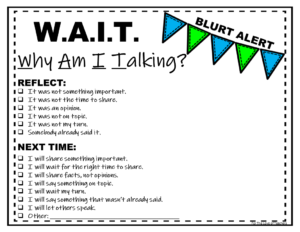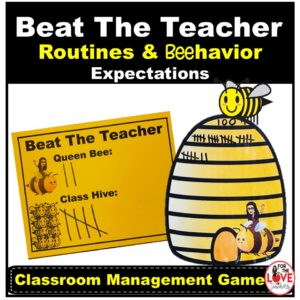
Being both an elementary teacher and classroom management coach, I have seen and heard all kinds of “talk” go on in classrooms from primary grades to high school. With strong classroom management, much of the talk can remain on topic and can promote a good level of conversation and thinking. As today’s kids spend more and more time behind screens and on social media, classroom “talk” can easily go off course rather quickly wasting valuable instructional time.
In my 15+ years in the classroom I’ve encountered all kinds of talkers:
- The Chatty Cathys- these students will talk to anyone about anything no matter where you seat them
- The Blurters- these students will call out everything they think and feel all the time
- The Complainers- these students always have something negative to gripe about
- The Quiet Ones- these students may never say a word aloud but may be doing a lot of thinking
The groups, The Chatty Cathys, The Blurters & The Complainers all contribute to something that keeps the quiet ones quiet, killing creativity. These “creativity killers” throw off what could be great discussions and suppress others’ ideas before they ever get a chance to come to fruition.
So how do we find the balance? We want students to talk and to find their voice. We want students to have freedom of speech and share their thoughts and opinions openly and freely. But we also want students to think before they speak, to reflect upon their words, filtering their words to bring about meaningful conversations that trigger higher-order thinking and creativity. Let’s engage them in meaningful conversations and discussions and cut out the meaningless blurts.
But how?
Here’s where the acronym W.A.I.T. comes in, Why Am I Talking? Perhaps you’ve seen this acronym posted in places of business or at conferences. I came across this at https://www.vworkteam.com/blog and thought that this is not only effective in business meetings and conferences but is also a great classroom management tool.

W.A.I.T. brings attention to why and when someone is talking, allowing them to reflect on their thoughts and words paying close attention to how and what they contribute to conversations and discussions. It allows them to be more reflective before they speak and more intentional with their words.
How to use this tool in the classroom:
- Review the W.A.I.T. flowchart with your class. Post it somewhere visible where you and students can refer to before having a discussion or doing a group activity (whole group or small group).
- W.A.I.T. Reflection Form – For repeat blurters, have them reflect and fill out the blurt alert form. Sometimes we need to give those students a little nudge to reflect on why they are talking and remind them to contribute with purpose.

- Blurt Alert Points – I use my Beat The Teacher class hive and give my class points if they don’t blurt out. If they do then I get a point.

Try saying something like:
“I noticed that our class discussion went really well. You all spoke when it was your turn, respectfully contributing with responses that were on topic. You get a point in our class hive.”
OR
“That class discussion could have gone better. We had many students talking out of turn and calling out responses that were not helpful or necessary in moving our discussion along. That wasted instructional time and stopped other students from contributing. I get a point.”
After having your students reflect more about why they are talking, they will begin to notice more about what they say and if it is necessary, kind, & helpful. You’ll notice that your class discussions and activities both big and small go much more smoothly and you’ll save a lot of instructional time. You may see more peer respect in time.
Let’s be intentional about getting students to talk with purpose.
You can check out this W.A.I.T. classroom management tool here.

Follow me to be notified when new resources are uploaded to the Shop and join the email list to receive the latest and greatest updates, posts, and some awesome freebies!
If you like it, then pin it!



Christine Weis is a passionate educator, classroom management coach, wife, and mom of two busy boys. She enjoys teaching, writing, and creating resources for teachers.




This is just so school to learn a new technic. Even though I’m not a teacher which directly in need of this, but indirectly apply to other cases.
Thank you for the great infographic also!
This idea was originated for conferences and meetings. It’s definitely applicable to any workplace. Thanks for reading!
Christine at For The Love of Teachers
Wow! You have observed a lot! I like the classifications of students. Very helpful indeed!
Yes, I have! Thanks for reading!
Christine at For The Love of Teachers
I bet the kids do love the hive. This will help them create habits that they will remember for life!
Yes! Our class hive is a great way to earn incentives. They are motivated! Thanks for reading!
Christine at For The Love of Teachers
I think this is a wonderful article. This would be a helpful article for teachers who can really get ahold of the pace of the classroom.
Thank you! I hope it helps many new and seasoned teachers who need some strategies for those chatty classes. Thanks for reading!
Christine at For The Love of Teachers
i have a few friends that are teachers. i will def be sharing this with them. looks like great information.
Yes, please do share! Thanks for reading!
Christine at For The Love of Teachers
I love this! This is great for teachers and classrooms. However, I could use this at home with my children as well! Thank you for sharing!
Thank you! I’m so glad! I use many classroom management strategies with my own children too! Thanks for reading!
Christine at For The Love of Teachers
Very interesting concept. I would like to discuss this concept with my teacher friends. They will connect well with your idea.
Thank you! Feel free to share! Thanks for reading!
Christine at For The Love of Teachers
This is an awesome guide for teachers! I’m not positive where my kid falls on the chit chat chart, because he never tells me anything! But I hope his teacher does this type of routine with the class too.
Thank you! I love that…chit chat chart! Thanks for reading!
Christine at For The Love of Teachers
i adore educators so much. thank you for sharing this very informative and helpful post. <3 thank you also to your dedication…
nice!! your WAIT tool is fabulous. I would have loved reading this when i was considering being a teacher. i bet this is so helpful for teachers.
I love it. The flowchart should be taught to every student and the visual aid should be displayed in every classroom. I will send the link to this post to my teacher friend. She will find this very useful. I will also talk to my grandson’s pre-school teacher. Maybe she can put this in use in her class too.
Sending this to all my teacher friends, I’m sure they will find this informative